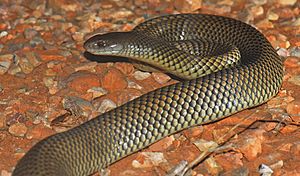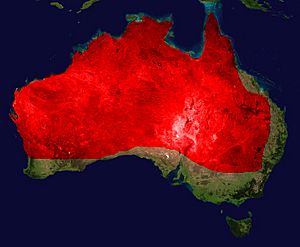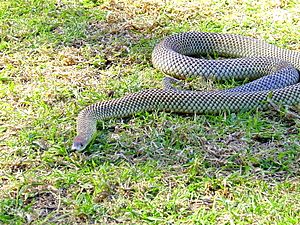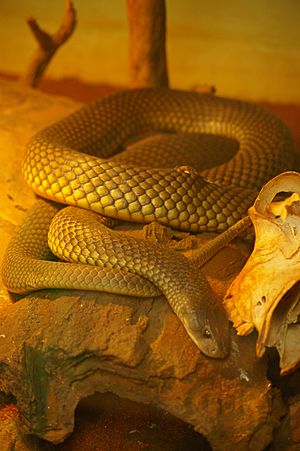King brown snake facts for kids
Quick facts for kids King brown snake |
|
|---|---|
 |
|
| Conservation status | |
| Scientific classification | |
| Genus: |
Pseudechis
|
| Species: |
australis
|
 |
|
| Range of king brown snake (in red) | |
| Synonyms | |
|
List
Naja australis Gray, 1842
Pseudechis darwiniensis Macleay, 1878 Pseudechis cupreus Boulenger, 1896 Pseudechis platycephalus Thomson, 1933 Denisonia brunnea Mitchell, 1951 Cannia centralis Wells & Wellington, 1985 |
|
The king brown snake (Pseudechis australis) is a highly venomous snake found across northern, western, and Central Australia. Even though it's called a "king brown snake," it's actually part of the Pseudechis genus, also known as black snakes. This means it's not closely related to the "true brown snakes."
Another common name for this snake is the mulga snake. However, it lives in many different places, not just mulga habitats. It was first described in 1842 by an English zoologist named John Edward Gray. This snake is quite large and strong, growing up to 3.3 m (11 ft) long.
Its appearance can change depending on where it lives. Snakes from northern Australia are often tan, while those from the south are dark brown or even black. Sometimes, you might even see one with a reddish-green color. The scales on its back often have two tones, making the snake look patterned. Its belly is usually cream or white, sometimes with orange spots.
The king brown snake lays eggs. It is considered a least-concern species by the International Union for the Conservation of Nature (IUCN). This means its population is stable, though it might have decreased in some areas due to the spread of the cane toad.
The venom of the king brown snake is not as strong as some other dangerous Australian snakes. However, it can still cause serious problems if a large amount is injected. It mainly affects your muscles, causing weakness or paralysis. It can also affect how your blood clots. Bites often cause a lot of pain and swelling. In rare cases, it can cause tissue damage at the bite site. While bites can be very serious, deaths are rare, with the last recorded one in 1969. People bitten by this snake are treated with black-snake antivenom.
Contents
About the King Brown Snake Name
The king brown snake has had a few different names over time. When it was first discovered in 1842, it was thought to be similar to the Egyptian cobra. Later, scientists realized it was more like the Australian black snakes.
The name "king brown snake" can be a bit confusing. Its venom is not treated with brown-snake antivenom, which could be dangerous if someone is bitten. Because of this, some experts suggest using the name "mulga snake" instead. However, "mulga snake" also has issues because the snake lives in many places, not just mulga trees. It's also been called the "Pilbara cobra."
In some Aboriginal languages, it has special names. For example, in the Kaytetye language, it's called atetherr-ayne-wene, which means "budgerigar-eater." The "King Brown" part of its name comes from how large these snakes can get in northern Australia, sometimes over 3 m (10 ft) long. They are the biggest and most dangerous venomous snakes in those areas. In Southwest Australia, where they are smaller (up to 2 m (6 ft 7 in)), they are also known as the common mulga snake.
Appearance and Size
The king brown snake is Australia's largest venomous snake. It can grow to be 2.0 to 2.5 m (6.6 to 8.2 ft) long and weigh between 3 to 6 kg (6.6 to 13.2 lb). Its belly is usually cream, white, or salmon, and it might have orange markings.
The colors on the snake's back and sides vary depending on where it lives. Snakes from northern Australia are often tan. Those from the deserts in Central Australia have clear white marks on each scale, making them look patterned. Snakes from southern areas are darker, sometimes even blackish. In Western Australia, king brown snakes found south of a certain line are much darker in color.
Scales on the Body
The number and pattern of scales on a snake's body help scientists identify its species. The king brown snake has 17 rows of scales around its middle. It has between 185 and 225 belly scales and 50 to 75 scales under its tail. The scale near its temple and the last scale above its mouth are separate. This helps tell it apart from the eastern brown snake, where these scales are joined.
Sometimes, the king brown snake can be mistaken for other snakes. These include brown snakes, the olive python, water python, spotted mulga snake, or coastal taipan.
Where They Live and Their Home
King brown snakes are found in all Australian states except Victoria and Tasmania. They have become rare or disappeared from some coastal areas in Queensland.
These snakes can live in many different places. They are found in woodlands, grassy areas, scrublands, and sandy deserts. However, in dry areas, they prefer places with more moisture, like near water.
You might also see them in places changed by humans, such as wheat fields, rubbish piles, or empty buildings. Sometimes, they get stuck in mine shafts. Research near Alice Springs showed they like areas with buffel grass. This grass is a common weed in Central Australia and provides good cover for the snakes all year round.
Behavior
The king brown snake is mostly active at dusk, which is when the sun is setting. It is less active in the middle of the day and between midnight and dawn. During these times, it hides in cracks in the ground, old animal burrows, or under rocks and logs.
In warmer months, it becomes active later in the evening. In cooler climates, it is more active during the day. In hotter climates, it is more active at night.
Reproduction and Life Cycle
The breeding season starts with male snakes wrestling. They try to push each other over to win the right to mate with a female. Mating happens in early spring in some parts of Australia and during the wet season in the north.
Female king brown snakes lay eggs. They usually lay a clutch of 4 to 19 eggs, with about 10 eggs on average. Longer females tend to lay more eggs. Eggs are laid about 39 to 45 days after mating. The eggs take about 70 to 100 days to hatch. The ideal temperature for eggs to hatch is between 22 and 32 °C (72 and 90 °F). Each egg is about 40.1 mm (1+5⁄8 in) long and weighs 13.1 g (0.46 oz). Baby snakes are about 22.6 cm (8+7⁄8 in) long and weigh 9.4 g (0.33 oz) when they hatch.
King brown snakes have been known to live for up to 25 years in zoos or other controlled environments.
What They Eat
The king brown snake eats many different animals. It preys on frogs, lizards (like small monitors, skinks, geckos), and other snakes. It also eats birds like thornbills, and small mammals like rodents.
These snakes are also known to eat roadkill and even the shed skins of other reptiles. They can also eat other king brown snakes (cannibalism). In captivity, they have even been seen eating their own waste. They are flexible eaters, for example, eating more frogs in wetter areas.
King brown snakes are sensitive to cane toad toxins. They can die if they eat cane toads. However, studies in some areas showed that their numbers did not drop after cane toads arrived. This might be because their population was already declining there.
Venom and Bites
The king brown snake was responsible for 4% of identified snakebites in Australia between 2005 and 2015. No deaths were recorded during this period. The last recorded death was in 1969. This incident led to the use of Papuan black snake antivenom for king brown snake bites.
Venomous snakes usually only bite humans if they feel threatened. However, king brown snakes have been known to bite people who were asleep. Many victims have also been snake handlers. This means many bites happen on the arms. The World Health Organization considers the king brown snake a snake of medical importance.
A king brown snake can bite multiple times and chew to inject more venom. Bites often cause a lot of pain, swelling, and tissue damage at the bite site. Tissue death has been reported. A large king brown snake can deliver about 180 mg of venom in one bite. One very large snake produced 1500 mg of venom in a single milking, which is a huge amount. This is similar to the amount of venom produced by the king cobra.
The main harmful substances in king brown snake venom are myotoxins. These damage muscles and kidney cells. The more venom injected, the more serious the effects. Common symptoms include feeling sick, vomiting, stomach pain, diarrhea, sweating, and headache. Blood clotting problems are also common. Muscle damage can cause muscle pain and weakness. Some people might also have a temporary drop in red blood cells.
King brown snake venom contains special proteins called phospholipase A2 enzymes. These proteins are very harmful to muscle tissue and can destroy cell membranes. Despite having these powerful enzymes, the venom does not cause much damage to the nervous system.
The venom also has proteins that fight bacteria. These include two L-amino-acid oxidases that work against a common bacterium found in frogs. There are also proteins called transferrins, which bind iron and make it harder for bacteria to grow.
Treatment for Bites
If someone is bitten by a suspected venomous snake, the first thing to do is apply a pressure bandage to the bite area. The person should move as little as possible and be taken to a hospital or clinic right away. They will need to be watched for at least 24 hours.
A tetanus vaccine is usually given. The most important part of treatment is giving the correct antivenom. For king brown snake bites, black-snake antivenom is used. Experts suggest giving antivenom as soon as possible if a king brown snake bite is suspected. Waiting too long might not prevent muscle damage. If a bite victim has blood clotting problems and signs of red blood cell damage, it's likely a king brown snake bite. Sometimes, more than one vial of antivenom might be needed for severe bites.
Keeping Them in Captivity
King brown snakes are available in Australia from captive breeding programs. They are considered relatively easy to keep as pets because they are less likely to bite and their venom is not as toxic as some other snakes. However, the large amount of venom they can inject still makes them dangerous.
Conservation and Threats
The king brown snake is listed as a least-concern species by the International Union for Conservation of Nature. This means it is not currently at high risk of extinction. Young snakes can be eaten by birds of prey. Older snakes are often found with ticks.
Culture and Stories
In Aboriginal culture, the king brown snake plays an important role in many stories.
At Mutitjulu Waterhole near Uluru, there's a story about two ancestral beings: Kuniya (a woma python woman) and Liru (a king brown snake man). Kuniya got revenge on Liru for killing her nephew by hitting him with her digging stick.
Among the Djambarrpuyŋu people in Arnhem Land, the King Brown Snake is an important ancestor named Ngurruyurrtjurr. Its homeland is Flinders Point.
Known as darrpa to Indigenous people of East Arnhem Land, the king brown snake was historically responsible for deaths there. There were traditional beliefs about treating bites, like watching the snake bleed to help the victim recover. If the snake was killed, it was believed the victim would also die.
In Gunwinggu country in West Arnhem Land, the king brown snake was called dadbe. The Kurulk clan would not collect white paint from a certain site during the wet season. They believed it was the snake's waste and feared its anger.
Kurrmurnnyini is a lagoon and rock area in the Northern Territory. Here, the King Brown Snake Ancestral Being was sleeping when it was disturbed. Angrily, it bit the rocks, making them poisonous. Local sorcerers would use these rocks to cast spells. Only men descended from the King Brown Snake Ancestor could be sorcerers. People feared and avoided this place.
A king brown snake is picked up by the main character in the 1986 film Crocodile Dundee.
See also
 In Spanish: Serpiente de Mulga para niños
In Spanish: Serpiente de Mulga para niños




